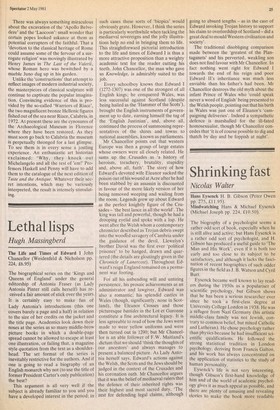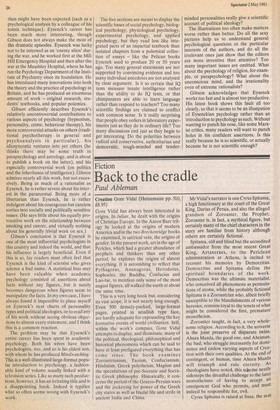Shrinking fast
Nicolas Walter
Hans Eysenck H. B. Gibson (Peter Owen pp. 275, f11.95).
Mindwatching Hans & Michael Eysenck (Michael Joseph pp. 224, L10.50).
The biography of a psychologist seems a rather odd sort of book, especially when he is still alive and active; but Hans Eysenck is a rather odd sort of psychologist, and H. Gibson has produced a useful guide to 'The Man and His Work', even if it is both too early and too close to its subject to be satisfactory, and although it lacks the fascination of recent biographies of such odder figures in the field as J. B. Watson and Cyril Burt.
Eysenck became well known to lay readers during the 1950s as a populariser of scientific psychology, but Gibson shows that he has been a serious researcher ever since he took a first-class degree at University College London in 1938. He was a refugee from Nazi Germany (his artistic • middle-class family was not Jewish, contrary to common belief, but. mixed Catholic and Lutheran). He chose psychology rather than physics because he had insufficient scientific qualifications. He followed the strong statistical tradition in London psychology, deriving from Francis Galton, and his work has always concentrated on the application of statistics to the study of human personality.
Eysenck's life is not very interesting, though Gibson's first-hand knowledge of him and of the world of academic psychology gives it as much appeal as possible, and there are plenty of amusing and revealing stories to make the book more readable than might have been expected (such as a psychological analysis by a colleague of his tennis technique). Eysenck's career has been much more interesting, though Gibson does not always make the most of the dramatic episodes. Eysenck was lucky not to be interned as an 'enemy alien' during the war, and he worked first at the Mill Hill Emergency Hospital and then after the war at the Maudsley Hospital, where he has run the Psychology Department of the Institute of Psychiatry since its foundation. He has introduced many innovations into both the theory and the practice of psychology in Britain, and he has produced an enormous amount of work — original research, students' textbooks, and popular polemics.
Gibson efficiently describes Eysenck's relatively uncontroversial contributions to various aspects of psychology (hypnotism, personality, crime, behaviour therapy), his more controversial attacks on others (traditional psychotherapy in general and psychoanalysis in particular), his idiosyncratic ventures into yet others (he thinks there may be some truth in parapsychology and astrology, and is about to publish a book on the latter), and his especially controversial work (on politics and the inheritance of intelligence). Gibson admires nearly all this work, but not excessively. Being as much of a rationalist as Eysenck, he is rather severe about his interest in the paranormal. Being more of a libertarian than Eysenck, he is rather indulgent about his courageous but careless sorties into socially and politically sensitive issues. (He says little about his equally provocative work on the relationship between smoking and cancer, and virtually nothing about his generally trivial work on sex.) Gibson's conclusion is that Eysenck is one of the most influential psychologists in this country and indeed the world, and that his influence is largely beneficial. Even if this is so, lay readers must often feel that Eysenck is the kind of scientist who gives science a bad name. A statistical bias may have been valuable when academic psychology consisted of assertions about facts without any figures, but it surely becomes dangerous when figures seem to manipulate the facts. In my own case, I have always found it impossible to place myself on Eysenck's neat charts of personality types and political ideologies, or to read any of his work without seeing obvious objections to almost every statement, and I think this is a common reaction.
The problem may be that Eysenck's entire career has been spent in academic psychology. Both his wives have been psychologists, too, and so is his eldest son, with whom he has produced Mindwatching.
This is a well-illustrated large-format popu lar introduction to psychology, a fashionable kind of volume usually linked with a television series. Like so many such productions, however, it has an irritating title and is a disappointing book. Indeed it typifies what so often seems wrong with Eysenck's work. The five sections are meant to display the scientific bases of social psychology, biological psychology, physiological psychology, experimental psychology, and applied psychology, but they read less like integrated parts of an impartial textbook than isolated chapters from a polemical collection of essays — like the Pelican books Eysenck used to produce 20 or 30 years ago. Too many general statements are not supported by convincing evidence and too many individual anecdotes are not analysed by clear argument. Is it so certain that IQ tests measure innate intelligence rather than the ability to do IQ tests, or that chimpanzees are able to learn language rather than respond to teachers? Too many scientific findings are claimed to conflict with common sense. Is it really surprising that people obey orders in laboratory experiments just as they do in ordinary life? Too many discussions end just as they begin to get interesting. Do the polarities between radical and conservative, authoritarian and democratic, tough-minded and tender minded personalities really give a scientific account of political ideology?
The illustrations too often make matters worse rather than better. Do all the sexy pictures help us to understand general psychological questions or the particular interests of the authors, and do all the irrelevant ones just show that the editors are more inventive than attentive? Too many important issues are omitted. What about the psychology of religion, for example, or parapsychology? What about the unconscious mind, and the irrationality even of extreme rationalists?
Gibson acknowledges that Eysenck works too fast and is almost too productive. His latest book shows this fault all too clearly, so that it seems to be an illustration of Eysenckian psychology rather than an introduction to psychology as such. Without wanting to punch his nose, like some Marxist critics, many readers will want to punch holes in his confident assertions. Is this really because he is so scientific, or actually because he is not scientific enough?



















































































 Previous page
Previous page